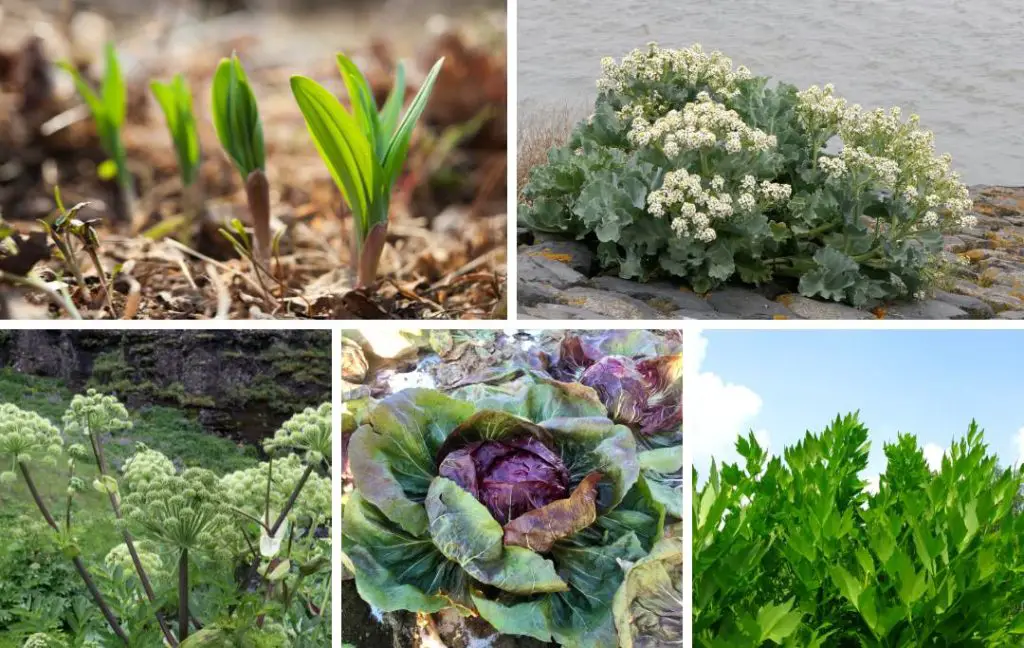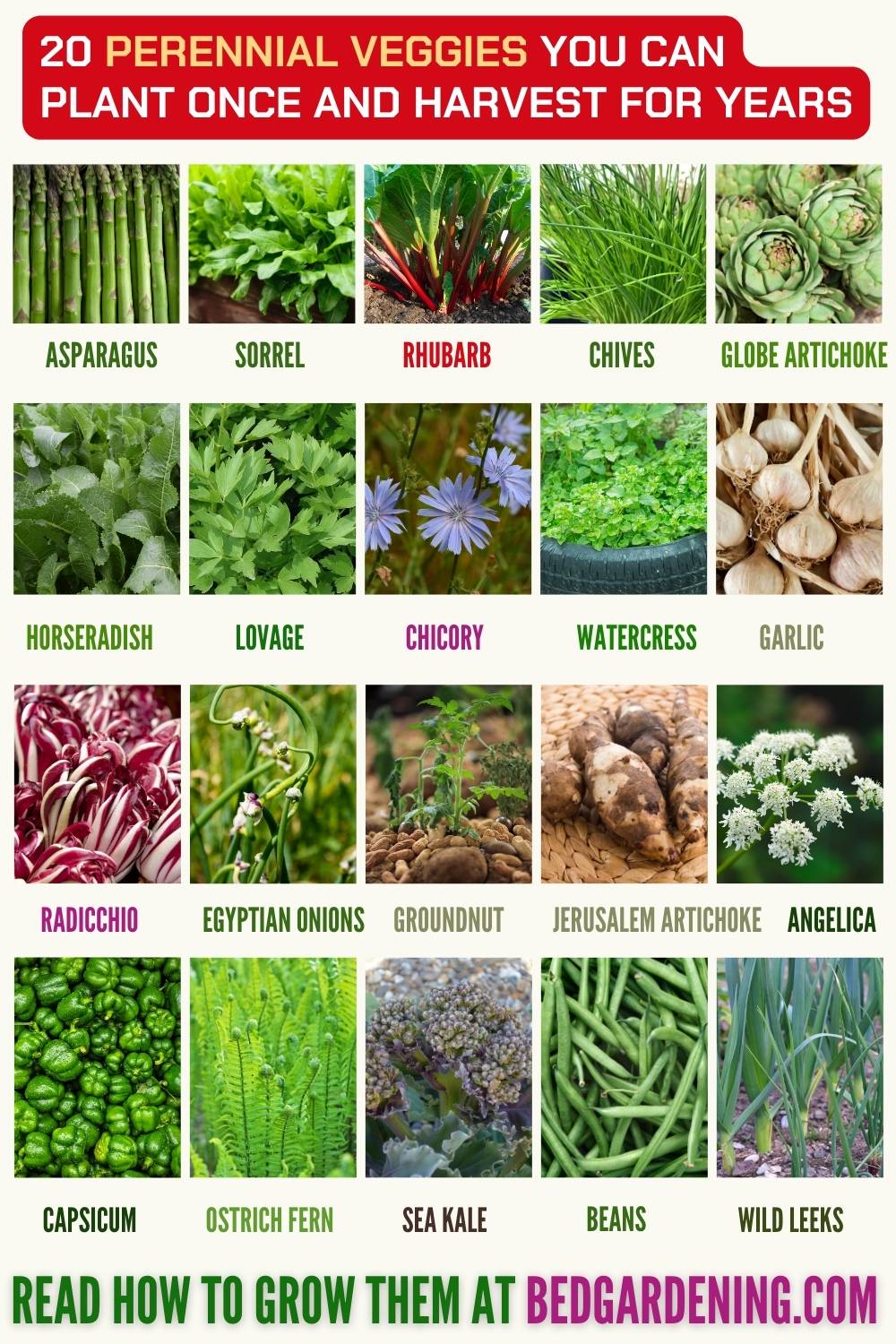A vegetable garden supplies fresh veggies for your kitchen. Fresh veggies from your own garden are better than store-bought vegetables. Now we will discuss what perennial vegetables are.
These crops are planted once and harvested year after year. Perennial vegetables are more nutritious than annual crops. These ecologically beneficial plants need little maintenance.
Reasons To Plant Perennials

Following are the reasons for selecting these beneficial perennial crops for your vegetable garden.
1- LOW MAINTENANCE
When you select perennial vegetables for your garden then you should not worry about watering and planting. These nutritious crops produce healthy vegetables throughout the season.
Perennial vegetables are pest and disease-resistant. When you select these crops for your kitchen garden then weeds and drought are no more problems. Once perennial plants are established in their permanent site they can take care of themselves.
2- EXTEND THE HARVEST
Perennial vegetables provide more food throughout the year. The higher yield is the basic reason for growing perennial vegetables. If you choose annual vegetables for your garden then when you are waiting to transplant the young seedlings. On the other hand, the perennials are already established and ready to harvest.
3- PERENNIAL VEGETABLES CAN PERFORM MULTIPLE GARDEN FUNCTIONS
The other reason for choosing perennial vegetables for the garden is that they are ornamental and beautiful plants that can enhance the beauty of your landscape.
You can also use them as ground covers. They can also perform the function of erosion control for slopes. Perennial veggies can fertilize themselves and their neighboring plant. They can fix the nitrogen level in the soil. They also provide a habitat for beneficial insects.
4- PERENNIAL VEGETABLE HELP IN BUILDING SOIL
Perennial plants help to build the soil because there is no need for tilling these crops provide habitat for fungi and other important soil life. For better results, you have to apply a layer of mulch on the surface of the soil so perennial plants can improve the soil’s structure.
Perennial crops help to make your soil richer naturally. They add more and more organic mortar by slowing and steady decomposition of roots and leaves.
When the perennial plants mature they build topsoil and sequester atmospheric carbon. They also play an important role in the water-holding capacity of the soil.
20 Perennial Vegetables For Your Kitchen Garden

Annual vegetables such as potatoes, tomatoes, peppers, and beans are the favorites of many gardeners. They produce in a single growing season. In the next season, you have to plant them again.
But if we talk about perennial vegetables there is no need to replant every year. For this year’s vegetable garden, you must add some perennial veggies to your list.
These crops provide you with fresh food in the coming year without the hard work of replanting. Following are the 20 veggies that you can plant once but harvest year after year.
1- ASPARAGUS
This is a hardy crop that lasts for decades in your vegetable garden. Asparagus needs full sun exposure to thrive well. You must use well-drained and moist soil.
To make your soil richer you have to add compost before planting. As this plant is going to live in your garden for a long time, you have to prepare the soil before planting. You can use rooted crowns for growing asparagus before the last frost.
6 inches deep trenches should be dug in the soil. You must use a fertilizer that contains phosphate. The fertilizer that contains nitrogen promotes foliage so you must avoid it.
Keep Reading;
2- SORREL
This is a herb that has lemon-flavored leaves. The leaves of sorrel are used in soups, salad stews, and sauces. There are two types of sorrel: common sorrel and French sorrel.
This vegetable has a close relationship with rhubarb. Sorrel has a unique flavor that starts producing from spring till June after that it begins to flower.
Young and tender leaves of Sorrel give you the best taste. Warm weather is not good for this vegetable as the leaves become bitter as the temperature becomes high.
3- RHUBARB
If you are looking for a vegetable that can grow 10 years or more and is pest resistant and easy to grow then rhubarb is the best choice. The green stem of rhubarb is used in making pies, jams, crumbles, and sauces.
The best time for planting is in autumn or early spring. Make your soil richer by adding well-rotted manure or compost to it. Rhubarb grows well in full sun exposure but a partially shaded area is also suitable for it.
You need 1-year-old crowns for planting through rhubarb in your vegetable garden. Water your newly planted rhubarb on time. Keep the soil moist by consistently watering, especially on hot days when spring comes you should fertilize rhubarb plants by adding 10-10-10 fertilizer.
4- CHIVES
Chives belong to the onion family and produce beautiful flowers. You can easily transplant it because it is a hardy plant. The best time to plant chives in your vegetable garden is spring.
This vegetable likes to grow in cool climates. Before the flowers fully bloom you should harvest chives.
5- GLOBE ARTICHOKE
This is a perineal vegetable. The silver-green leaves of globe artichoke are long, just like giant ferns. A cool and humid environment is perfect for growing artichokes.
You must select a sunny spot in your garden for growing artichokes. Make your soil richer by adding aged manure or compost to the soil before planting. Keep the soil moist by adding consistent water. Avoid overwatering because it will result in root rot or many fungal diseases.
6- HORSERADISH
This vegetable is commonly grown for its roots. Horseradish has a strong flavor. This is a rooted vegetable so you should prepare the soil before planting it.
For rooted vegetables, your soil should be free from rocks and not compacted so the roots of the vegetable easily spread in the soil.
7- LOVAGE
Lavage is a perennial herb and grows up to 7 ft tall. This is a Hardy and easy-to-grow plant. Lovage like to grow in well-drained loamy and Sandy soil. The perfect pH of the soil must be 6.5 to 7.0.
Your crop will be ready to harvest after 85 to 95 days. It is better to choose a sunny area for growing lovage plants but it can also tolerate partial shade.
Maintain the frequency of water to keep the soil moist but avoid overwatering You should carefully examine the soil if it feels dry then it is time to water your plants.
8- CHICORY
This is a wonderful plant because you can eat its roots, leaves, and flowers. If you want a long healthy taproot then you must plant chicory from seeds.
You can sow the seeds directly in the permanent position in the spring. You should select a sunny area for chicory. Consistent moisture is needed for growing this easy-to-grow plant.
9- WATERCRESS
Watercress is a perennial aquatic herb and it likes to grow near running water. You can easily grow it at home. A light-shaded area is perfect for growing watercress but it also thrives well in a sunny location.
Keep the smile moist by regular watering because watercress loves to grow in wet soil. You can also grow this perennial herb in a small pot.
10- GARLIC
You can easily grow garlic as a perennial vegetable. The best time to plant garlic is in the fall and then ignore it for a few years. After a couple of seasons, garlic bulbs multiply on their own.
For planting garlic, you need individual cloves. After a few years, a single club will produce dozens of garlic bulbs. You can eat individual stems of this garlic mass at any time during the summer.
Keep Reading:
11- RADICCHIO
This plant is rich in vitamins B9, C, E, and K. You can propagate this plant by seed or transplant. You can select fully sunny for a partially shaded area to grow radicchio.
For a warm climate, you must select a partially shaded area. You can also grow this plant in a container after filling it with a high-quality potting mix.
12- EGYPTIAN ONIONS
This perennial onion can grow from the same root system each year. This vegetable can be a fabulous addition to your garden. The best time of planting Egypt and onions is in Spring or fall. You must use moist and well-drained soil.
13- GROUNDNUT
This is a vigorous plant and likes to grow in moist soil. That’s why groundnuts mostly grow beside the rivers and streams in their natural habitat.
This perineal vegetable plant grows 8 to 10 ft a year. You must grow it near a fence so it will get proper support or you can install our support structure. The tubers of the groundnut are held in a string just like a beaded necklace.
14- JERUSALEM ARTICHOKE
This plant needs little maintenance so you can easily choose for growing in your perennial vegetable garden. The best suitable soil for growing Jerusalem Artichoke must be well-drained and moist.
The ideal pH should be between 5.8 to 6.2. A full sun for a partially shaded area can be selected for growing Jerusalem artichoke.
15- ANGELICA
This herb is used to enhance the flavor of tea and liquors. In the first year, you will see a small growth of Angelica but in the second year, this herb grows very fast.
You have to replant it again after two or three years; it means it is a short-lived perennial.
16- CAPSICUM
Capsicum is a perennial vegetable but mostly known as annual. The reason is that they are badly affected by frost. That’s why you have to plant it, again and again, every year.
If you want to grow it as a perennial plant then it is better to pot them up and bring it indoors during winter. When spring comes then you can transplant it outside in your garden.
17- OSTRICH FERN
The ostrich fern is an ornamental plant. It can be grown for its flavourful fiddleheads. A cool and shady area is perfect for growing ostrich fern.
You can also grow it in deeply shaded areas in your garden but keep the soil moist. You can easily propagate ostrich fern by division of root ball.
18- SEA KALE
Grey blue leaves with white flowers have ornamental value. Young leaves, shoots, and flowers of sea kale are edible. The taste of this type of kale is similar to regular kale.
Sea kale is the choice of perennial vegetable gardeners and likes to grow in sandy soil. If you choose to grow sea kale from seed but it will take some time.
19- SCARLET RUNNER BEANS
This vegetable also is included in our perennial vegetable list because this plant lives about 20 or more years. In most areas of the world, this vegetable is grown for its ornamental value.
Scarlet runner beans are edible and full of nutrients. You can also use them in dried form. The tubers, leaves, and flowers are all edible when cooked.
20- WILD LEEKS
The flavor of the wild leek is just like a blend of spring onions and garlic. Wild leeks have elongated oval-shaped leaves. The flowers of wild leeks are pinkish-white.
Make sure you are using loamy soil for growing this perennial plant. The ideal pH of the soil must be between 6.8 to 7.2. Extreme sunlight and the heat of the summer are not suitable for wild leeks.
You should plant them at a place where they receive sheltered light. Wet soil is not good for wild leeks so you should carefully examine the moisture level of the soil.
